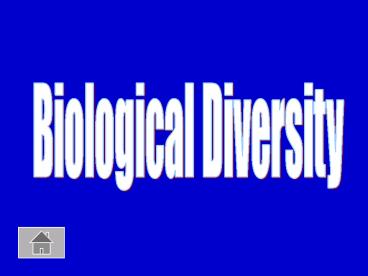Biological Diversity - PowerPoint PPT Presentation
1 / 63
Title:
Biological Diversity
Description:
How are bioindicator species used to determine the health of an ecosystem? State the parts of the pistil. Where in the body does meiosis take place? – PowerPoint PPT presentation
Number of Views:670
Avg rating:3.0/5.0
Title: Biological Diversity
1
Biological Diversity
2
World of Differences
Making Babies
Wearing Genes
Double helix
Selection Pressures
Hodge Podge
100
100
100
100
100
100
200
200
200
200
200
200
300
300
300
300
300
300
400
400
400
400
400
400
500
500
500
500
500
500
3
What are variations?
4
- The differences in a population.
5
Why are variations important in a population?
6
- Variations are important to ensure biological
diversity. Without diversity survival of a
population is questionable.
7
What is speciation?
8
- The evolution of different species from a single
ancestor.
9
What is the difference between a structural
adaptation and a behavioural adaptation?
10
- Structural physical
- Behavioural observed behaviour
11
What is an organisms niche?
12
- The role and location of that organism.
13
What are the four types of asexual reproduction?
14
- Binary fission, spores, vegetative growth
(meristems), and budding.
15
State one similarity and one difference between
asexual and sexual reproduction.
16
- Sim produce offspring traits passed on to
offspring. - Diff asex one parent, sex two more variation in
sex. produced offspring.
17
What is the advantage to internal fertilization
over external fertilization?
18
- Protects gametes from predators and harsh
environmental conditions.
19
Which came first, the embryo or the zygote?
20
- THE ZYGOTE!!!
21
List the parts of the stamen.
22
- Anther and Filament.
23
Explain the difference between continuous and
discrete variation.
24
- Continuous range
- Discrete limited possibilities
25
What does the statement nature vs. nuture refer
to?
26
- This is the ongoing debate over which factor
plays a larger role in determining a persons
characteristics.
27
How is it possible for a brown eyed couple to
have a blue eyed baby?
28
- Both parents carried and passed on a recessive
gene for blue eyes.
29
State three traits that are examples of discrete
variation.
30
- Polydactyly, blood type, tongue rolling, attached
earlobe, middigital hair, bent thumb
31
Explain why blonde haired couple shouldnt be
able to have a brown haired baby.
32
- Brown hair is dominant to blonde hair. Since both
parent are blonde, they are carrying recessive
forms of the gene. Any brown or dominant form
would be expressed.
33
Put the following genetic material in order from
smallest to largest Chromosomes, DNA, Genes
34
- Genes are a section of DNA DNA strands make up
chromosomes.
35
What does DNA stand for?
36
- Deoxyribonucleic Acid
37
Complete the following nitrogen base pairs A -
____ G - ____
38
- A - T
- G - C
39
What is the process responsible for the
production of gametes?
40
- Meiosis
41
If an organism has 34 chromosomes in a skin cell,
how many chromosomes will be in a red blood cell?
42
- 34
43
Who first proposed the theory of natural
selection?
44
- Charles Darwin
45
Explain conditions that would favour high levels
of variation in a population.
46
- When a population is faced with surviving a
catastrophe, disease, climate change, food
shortages, etc there are organisms in the
population that are better equipped to survive.
47
What are some advantages of biotechnology?
48
- Faster results, more control over the outcome,
insertion of human genes into other animals can
produce human proteins.
49
Why is there more bio diversity around the
equator?
50
- More water, more heat and more sunlight more
producers. The more producers you have, the more
consumers there can be to eat them.
51
How are bioindicator species used to determine
the health of an ecosystem?
52
- If the population of the indicator species is
thriving, then the ecosystem is healthy and able
to suppor them. If their numbers are low, then
their habitat is unable to support them.
53
State the parts of the pistil.
54
- Stigma, style, ovary and egg (ovum)
55
Where in the body does meiosis take place?
56
- In the sex organs (ovaries and testes)
57
What are the roles of zoos and seed banks in
maintaining bio diversity?
58
- Storage, breeding programs, conservation and
education
59
Explain how artificial and natural selection are
similar.
60
- They both are capable of producing great
diversity.
61
State two of the four parts of the theory of
natural selection.
62
- More offspring are produced than can possibly
survive. - Incredible variation within species.
- Variations increase the chance of an organism
surviving to reproduce. - Variations that are advantageous are passed on,
which leads to changes in the characteristics of
a species.
63
Daily Double































